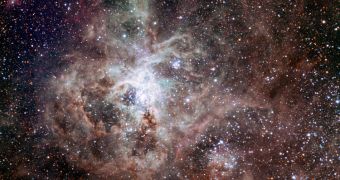In a recent study, experts investigated the feedback mechanisms influencing stellar formation in the renowned Tarantula Nebula, a beautiful cosmic structure.
When it comes to predicting how a molecular cloud in a stellar nursery behaves, experts rely on the Jeans Mass Criterion for predictions – but this approach fails to consider some elements that actually influence the overall systems.
For example, the theoretical predictions that the model makes are perfectly valid, but if the entire system of the gas and dust clouds that produce new stars is isolate from its surroundings.
Obviously, this is never the case in the actual Universe, where the clouds are influenced by factors exerting their influence from both the inside and the outside.
Some of these factors include for example the amount of radiation released by forming stars, supernova explosions of stars that have reached the end of their burning cycle, the ravages of solar winds on dust accumulations, the pressure and density of the stellar nursery itself, and so on.
Inside each stellar nursery, a massive race is taking place between developing stars. Each of them is trying to accrete as much mass as possible, and grow continuously, before the cloud is dispersed by various factors.
In a series of new studies, appear in the latest issue of the online journal arXiv, researchers look at the feedback mechanisms that develop within the stellar nursery Tarantula Nebula.
The team that carried out the investigations was led by astronomer Laura Lopez , who is based at the University of California in Santa Cruz (UCSC), Universe Today reports.
The mechanisms are extremely important, though subtle, because ultimately they're the ones that dictate how many stars are formed, and how large each of them will be.
The reason why the astronomers selected this nebula, also called 30 Doradus or NGC 2070, for their studies is the fact that it's located relatively close by, in the Large Magellanic Cloud.
Additionally, the cosmic structure also produce stars at a frantic pace, and so it provides astronomers and astrophysicists with many objects on which to study the actions of feedback mechanisms.
Given the size of the Tarantula Nebula, the team divided it into 441 individual regions, which made it easier to identify, classify and explain the feedback mechanisms at work in each section.

 14 DAY TRIAL //
14 DAY TRIAL //